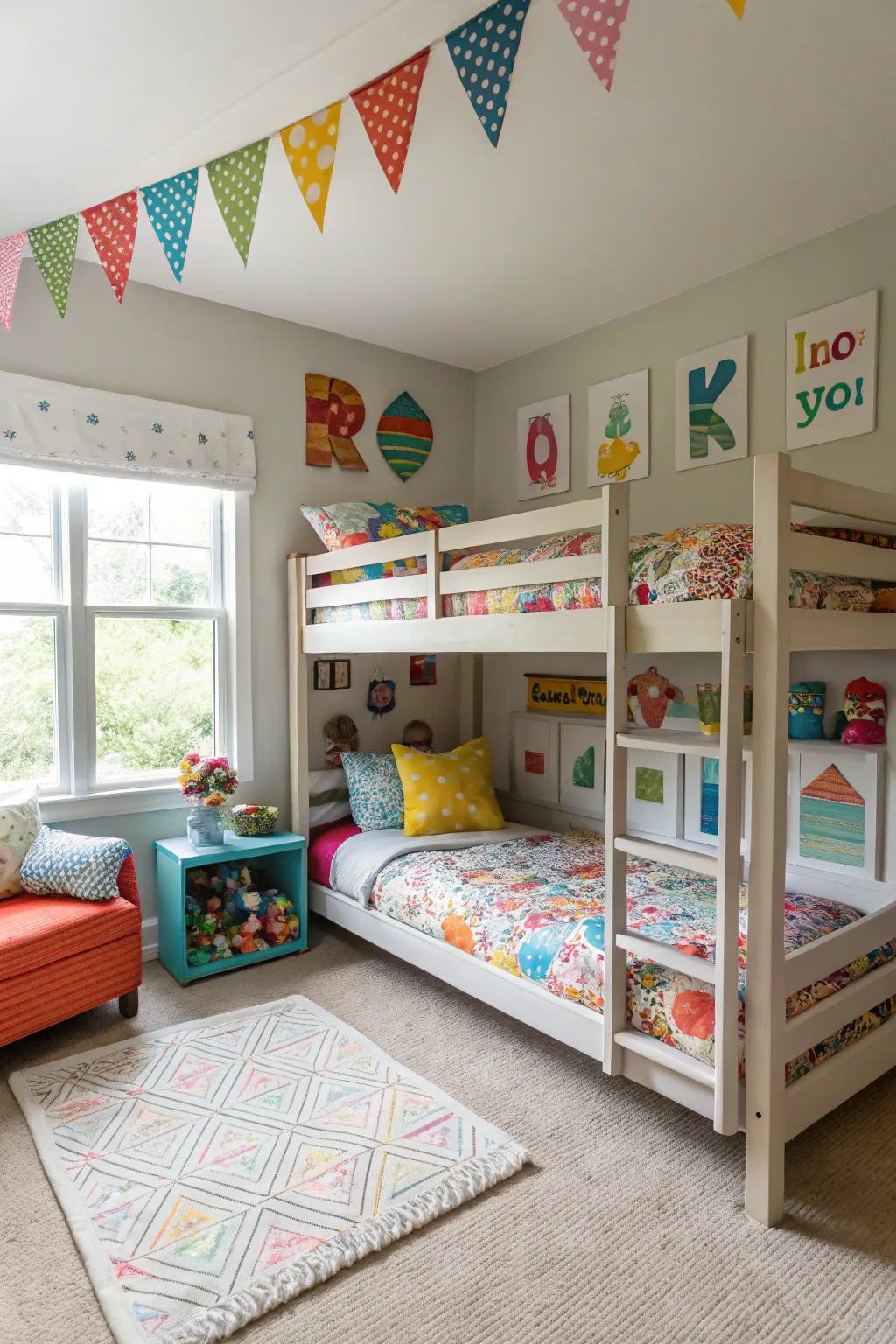Creating a shared bedroom in a compact space isn’t just a design challenge—it’s also an opportunity to spark creativity and connection. Whether you’re tackling a sibling duo, cousins, or even a guest situation, the way you shape their space can foster harmony and a sense of independence.
Trust me, with a few thoughtful touches, a small shared bedroom can become a cozy retreat that feels just right.
1. Smart Under-Bed Storage Solutions for Shared Spaces
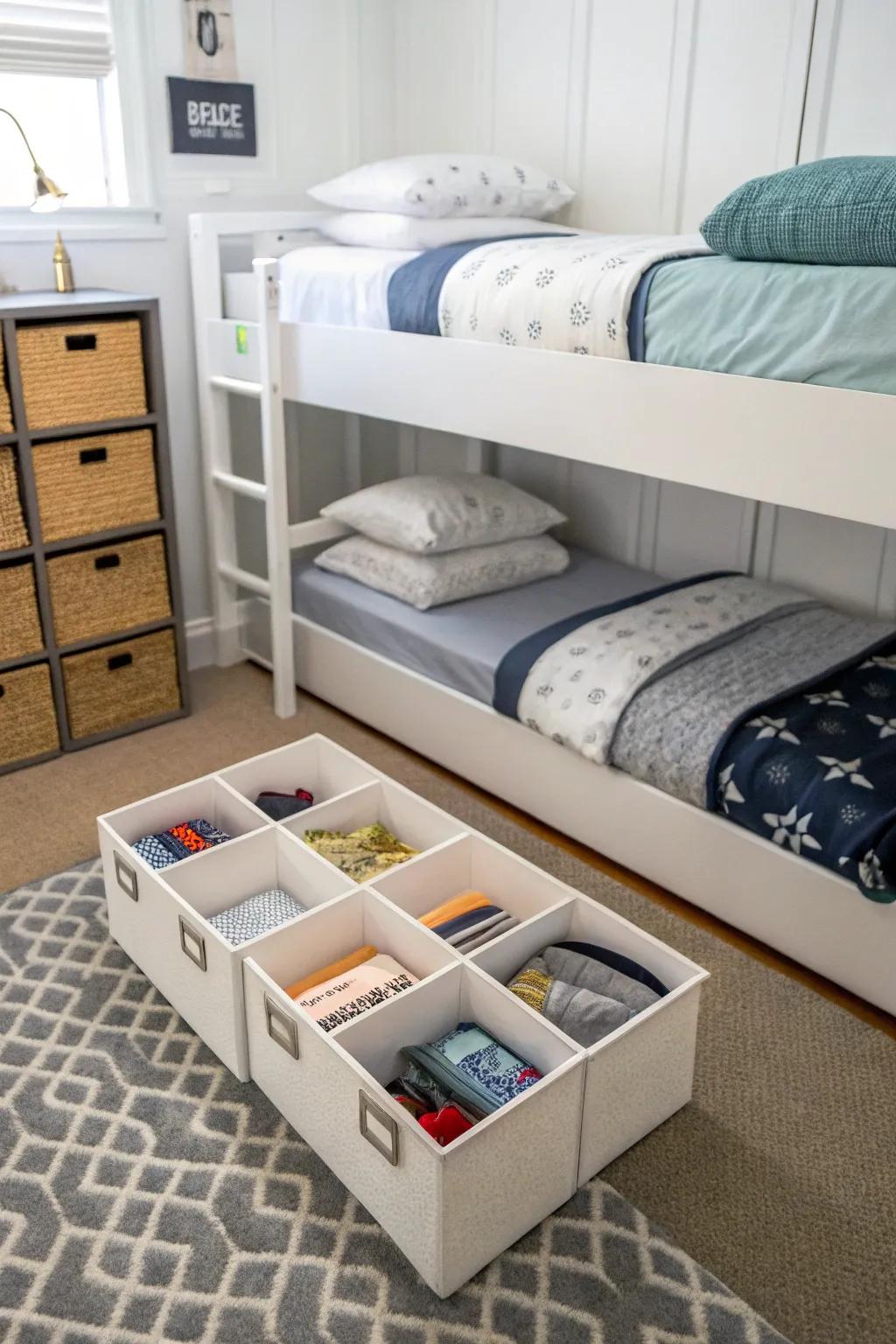
If there’s one secret weapon for shared bedrooms, it’s clever under-bed storage. I can’t count the times I’ve seen families stunned by the amount of clutter that simply disappears once this trick is in play. Think of it as a little magic trick for tidiness and peace.
Ready to reclaim your floors and calm the chaos?
- Modular rolling bins: Choose ones with sturdy wheels for effortless sliding.
- Foldable fabric boxes: These are ideal for soft items like out-of-season clothes or sports gear.
- Under-bed shoe racks: Keep shoes paired and organized, saving precious closet space.
- Stackable drawers: Pick shallow bins so you maximize vertical clearance without making things hard to reach.
A client of mine, the Kepler twins’ mom, once told me she felt like she got half a room back just by sliding in coordinated bins. With a little planning, you can turn even the narrowest under-bed zone into a neat and accessible storage station.
Consider these options:
2. Soft Hues, Happy Hearts: Choosing a Gentle Palette Together
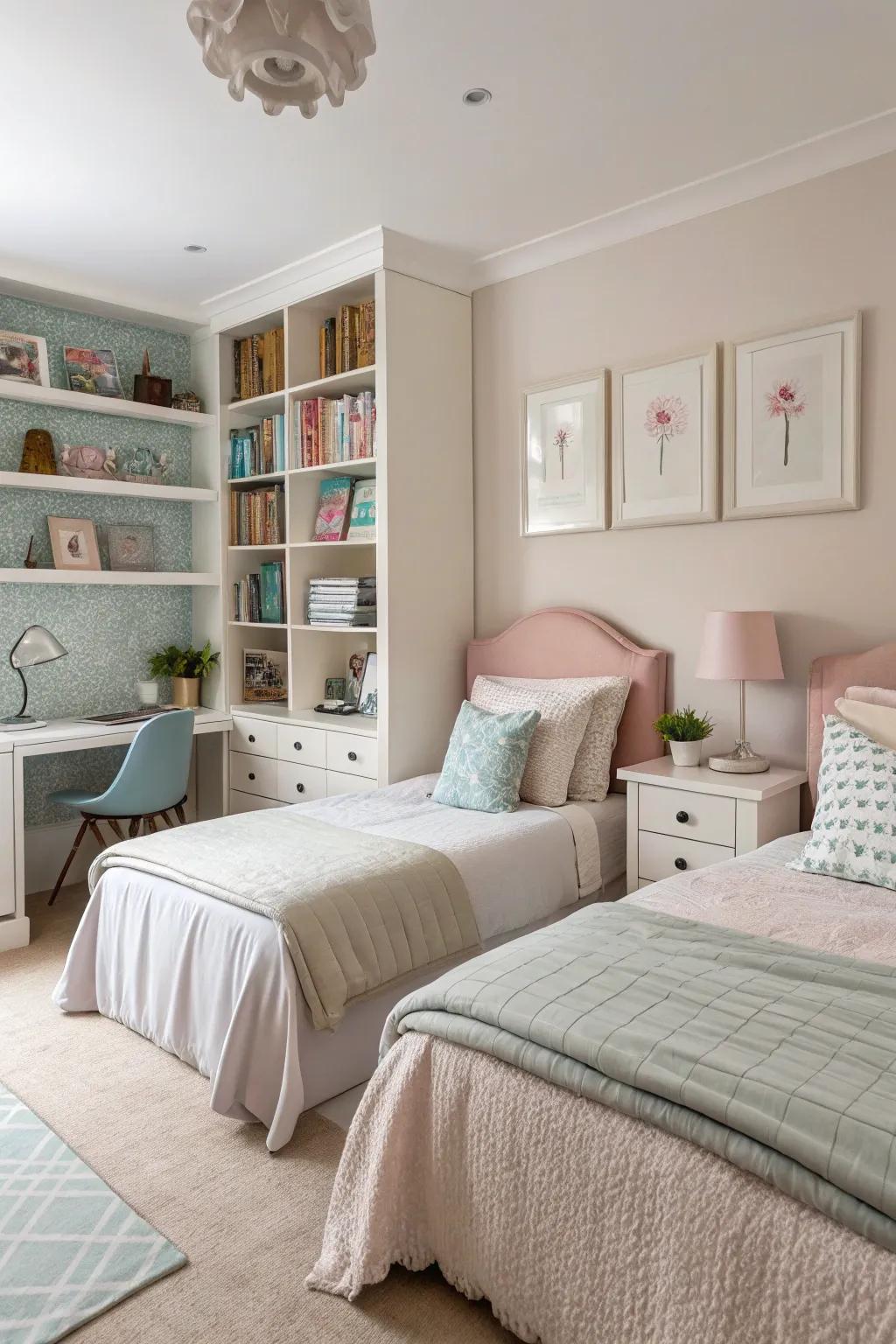
Color has a magical way of shaping the atmosphere in any room, but in a shared bedroom, its impact is multiplied. When you layer soft, muted tones, the space feels not only bigger but also more peaceful—inviting calm even when energy levels are high.
I remember working with Max and Olivia, a sibling pair who seemed absolute opposites in taste. Max wanted blue everything (the bolder, the better), while Olivia loved sandy creams and gentle sage. Instead of choosing sides, we explored the world of subtle blends. We landed on a gentle blue-gray for the walls and added cream accents in their bedding and decor. The result? Both felt heard, and their parents noticed bedtime became smoother—proof that a thoughtfully chosen color palette can harmonize more than just furniture.
Here are a few ways you can infuse serenity into your children’s shared room:
- Select 2-3 main hues that complement each other and alternate them on walls, bedding, and storage.
- Use natural materials—like linen curtains or jute rugs—in neutral shades to add warmth and softness.
- Accent with small pops of pastel (think blush, mint, or cornflower) for a playful touch without visual chaos.
- Keep larger furniture pieces light in color to help the room feel airy and open.
When in doubt, go softer—gentle colors rarely overwhelm.
Does your shared bedroom reflect the calm you want to cultivate, or is it ready for a gentle refresh?
You might give these a try:
3. Rise Up! Why Bunk Beds Unlock Shared Room Potential
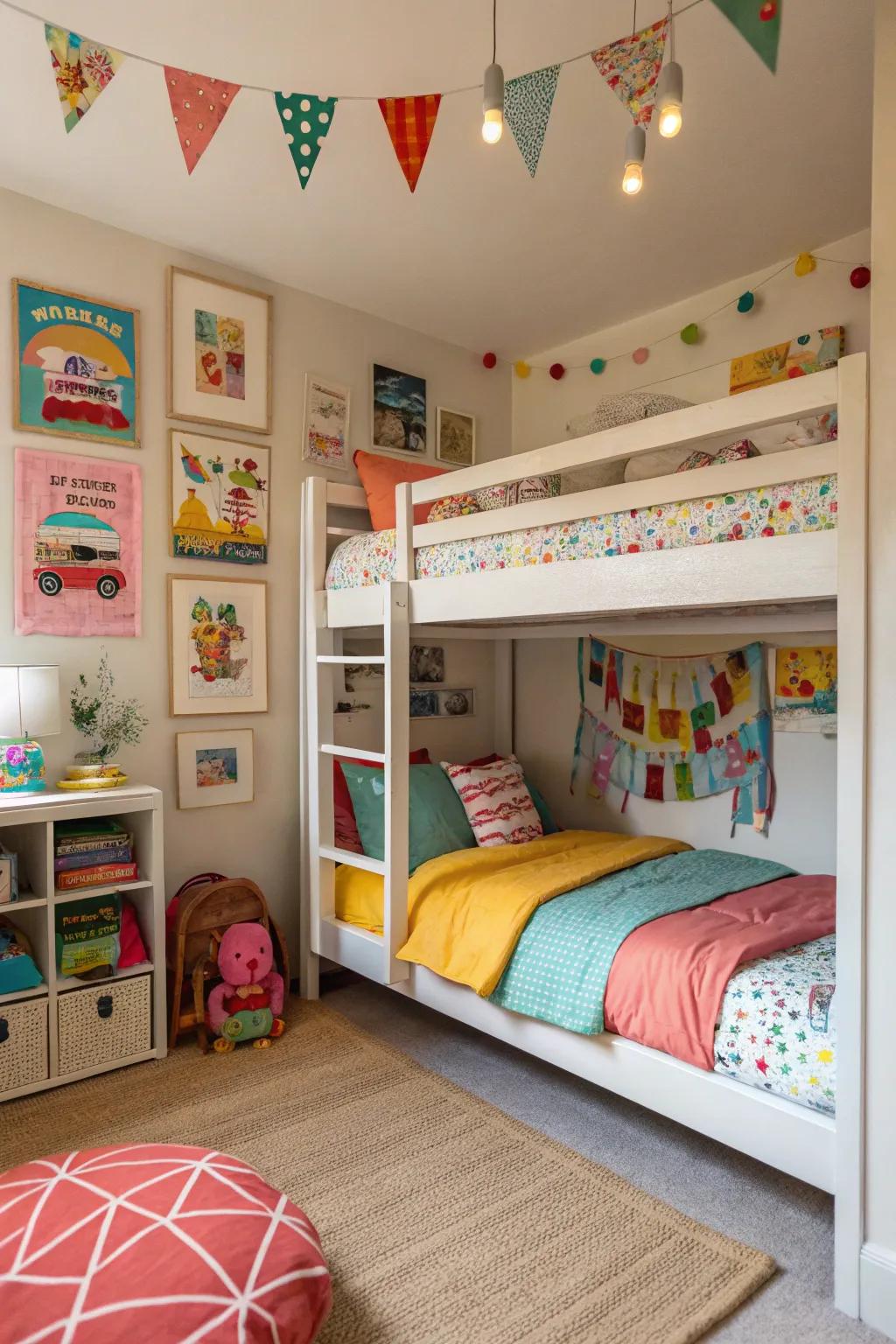
Bunk beds are more than just a nostalgic nod to childhood—they’re a true space-saving hero in any shared bedroom. By looking up rather than out, you can dramatically increase usable square footage and create room for everyone to breathe, play, and rest.
I once worked with a wonderful set of twin brothers, Max and Milo, who needed both floor space for their epic Lego battles and a dedicated area for schoolwork. Standard twin beds would have left their room feeling cramped, but with a sturdy bunk bed, we unlocked new possibilities. Suddenly, there was space for a reading nook and a mini desk zone, all without stepping on tiny plastic bricks.
- Bunk beds instantly double the sleeping space without expanding the footprint.
- The open space below or beside the bunks can be transformed for play, study, or clever storage.
- Modern bunk designs often include safety rails, built-in shelves, and fun features like ladders and slides.
Think about how this vertical approach encourages each child to take ownership of their “zone.” Whether it’s hanging their favorite art or arranging stuffed animals on the top bunk, personal touches go a long way.
Sometimes, all it takes is a little elevation—literally—to make a shared room work for everyone.
A few helpful options:
4. Every Inch Counts: Storage with Style
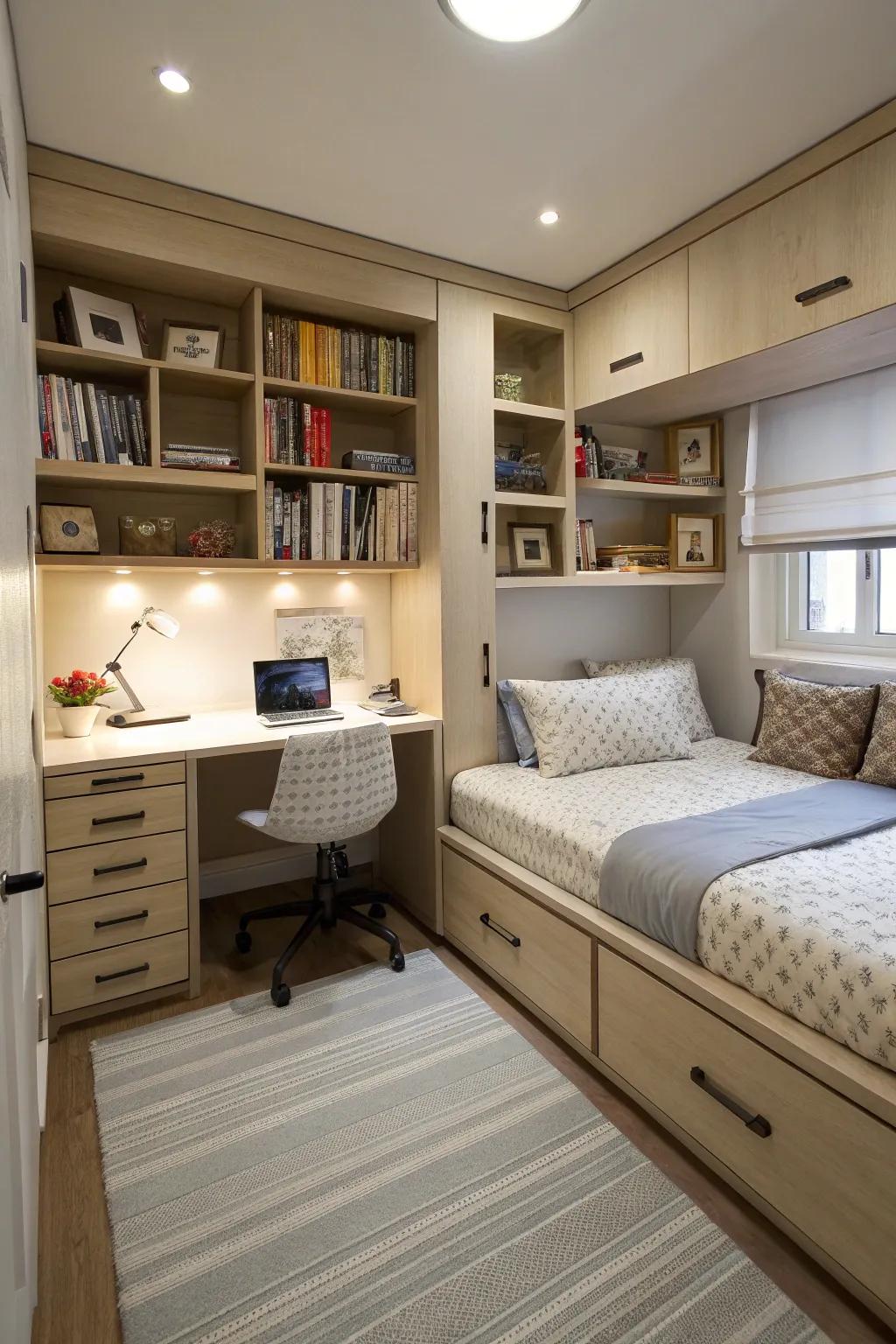
No space? No problem! Built-in storage transforms tight quarters into practical, peaceful retreats. When shelves, drawers, and cubbies hug the walls or fit under beds, there’s more floor space for play and creativity—and far less clutter. My favorite tip: add a storage bench at the foot of each bed for stashing treasures or homework essentials.
A few relevant products:
5. Use Mirrors to Expand Space
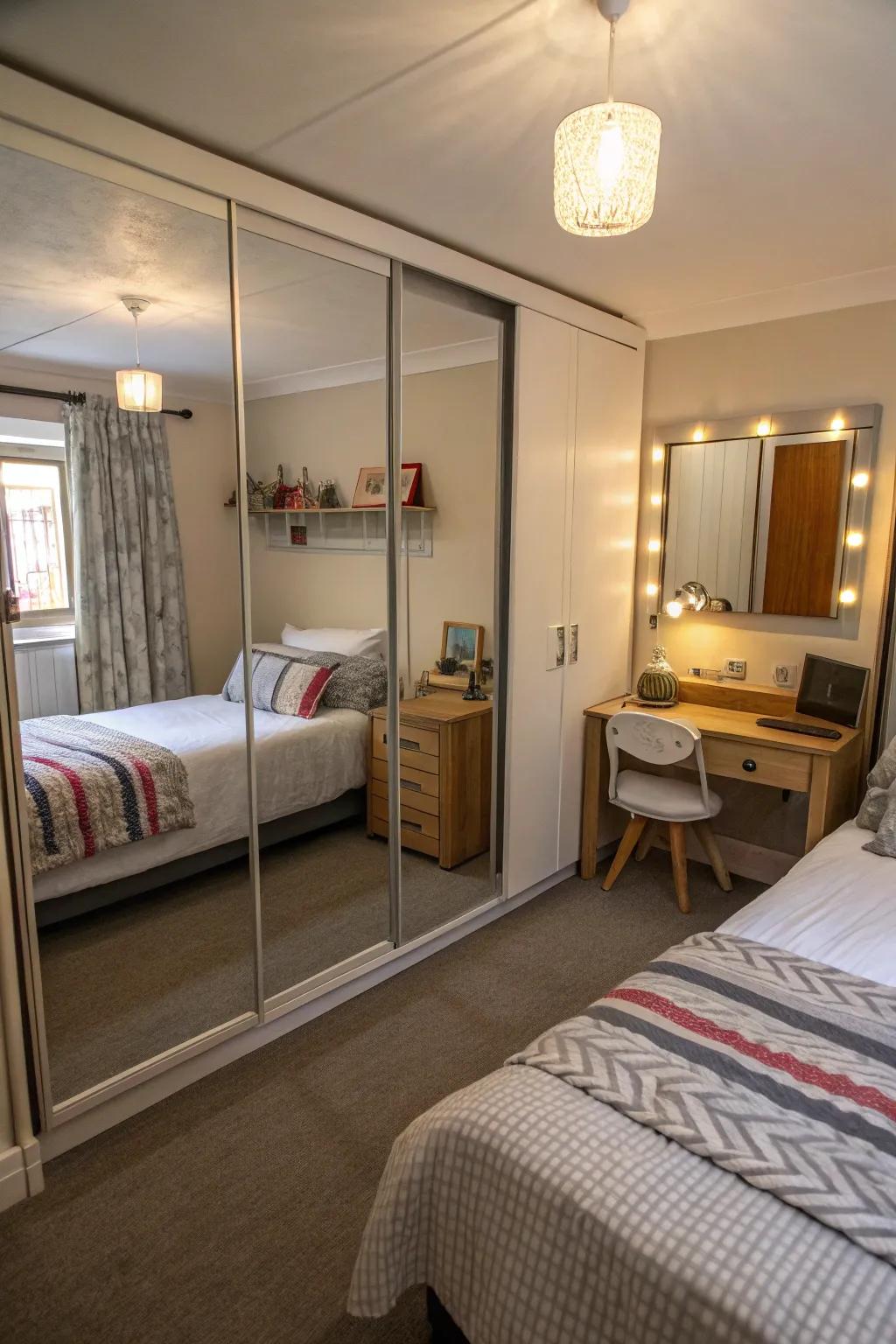
Mirrors can make a small room feel larger and more open. I often strategically place them to reflect light and create an illusion of more space in shared bedrooms.
Useful items to consider:
6. Why Not Paint It Personal?
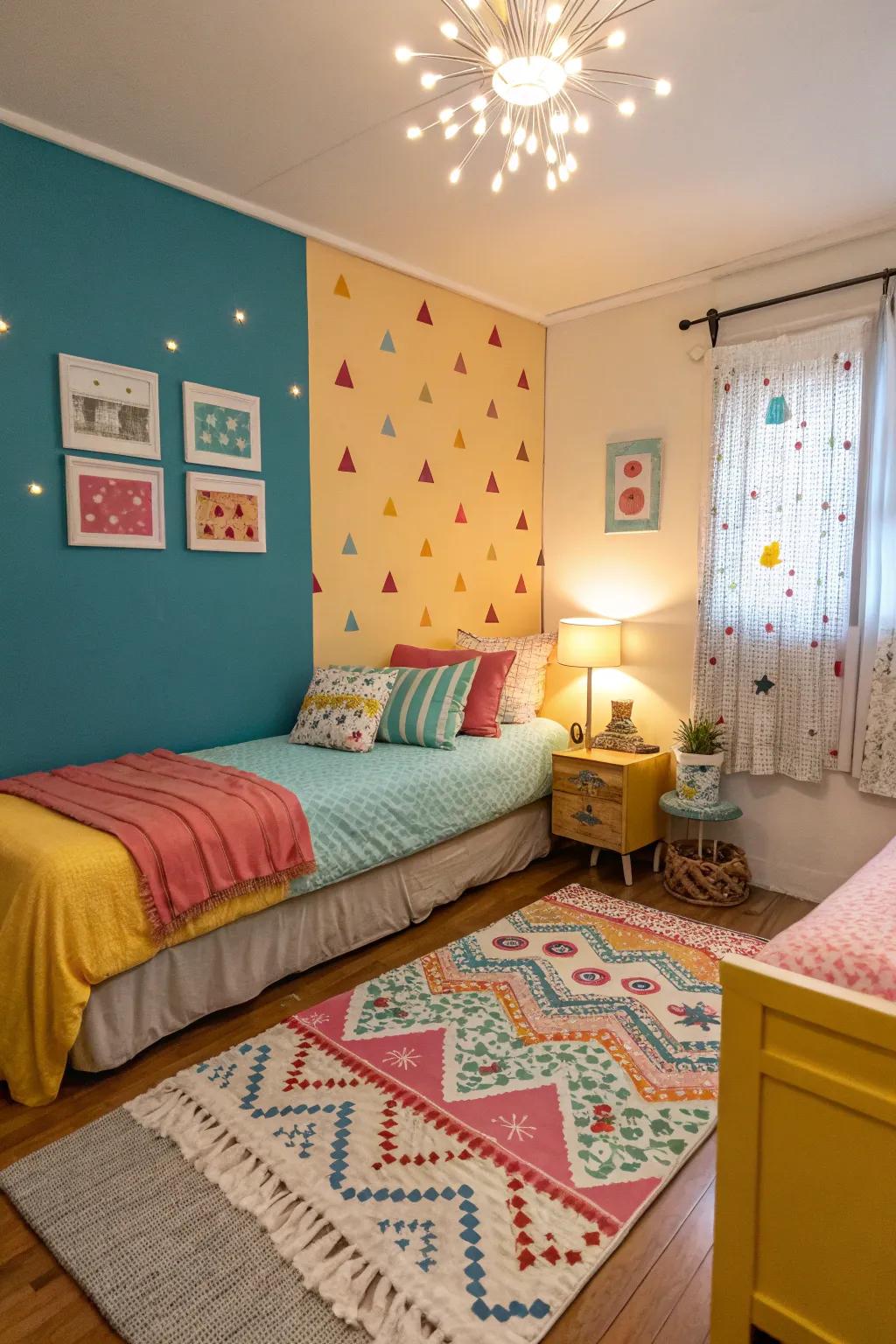
Color is the secret ingredient for creating a sense of individuality in a shared bedroom—without taking up a single square inch. I always urge parents to let each child pick a shade or pattern that speaks to them.
- Choose accent walls or headboards in favorite colors so each zone feels unique.
- Use removable wall decals for ever-changing tastes—no paintbrush required!
- Layer in bright bedding or throw pillows to help each side stand out.
The beauty of color coding is that it’s both playful and practical. With clearly defined zones, even a tiny room can feel twice as big.
Let their personalities pop—there’s no rulebook for what colors go where!
Check these products out:
7. Desk Time, Together
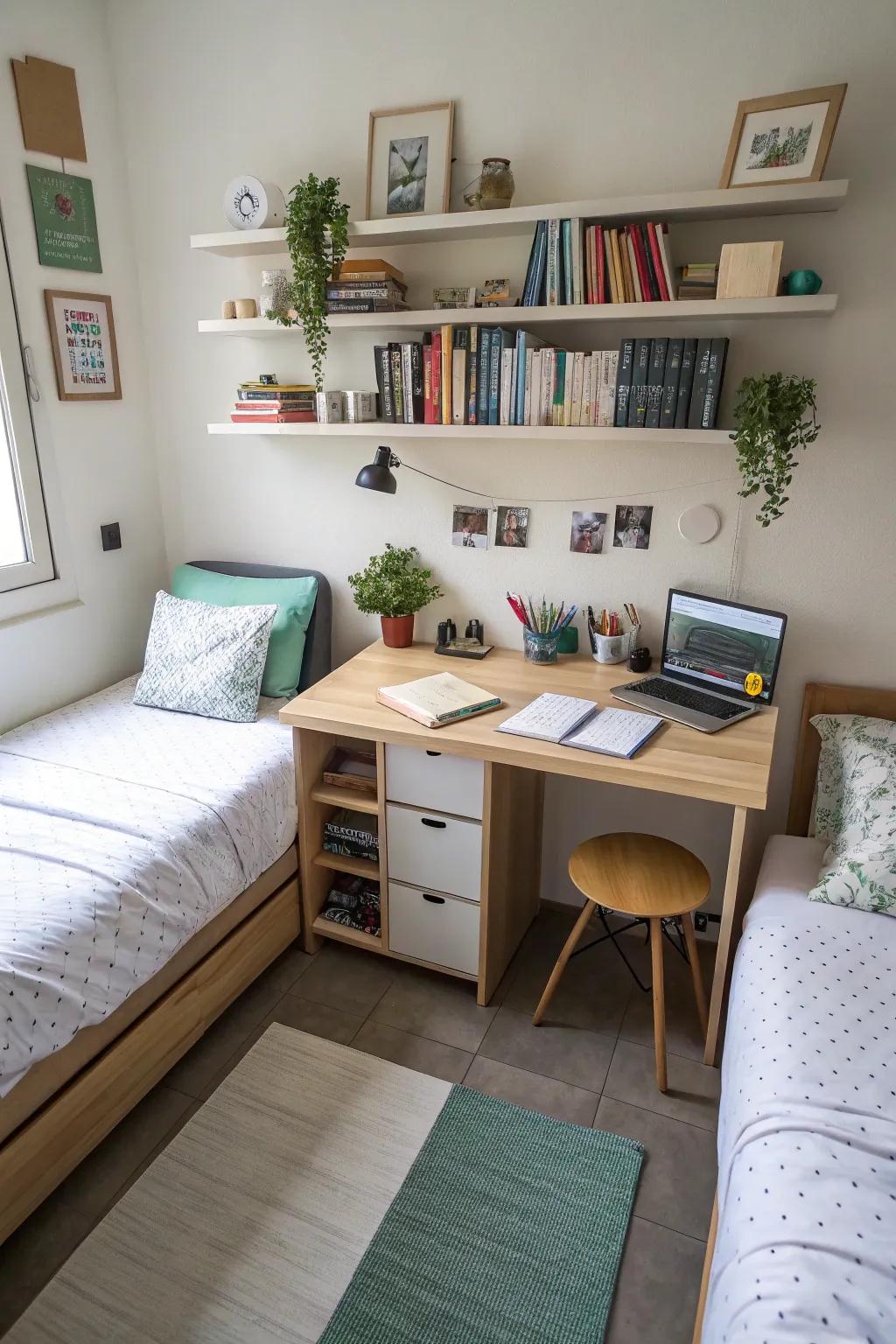
It’s amazing how a shared workspace can transform a bedroom into a little hub of creativity. If you’re working with tight quarters, look for furniture that does double duty and maximizes every inch.
Here are two quick ways to make the most of shared desk time:
- Choose a central desk with divided cubbies for each child.
- Add matching desk lamps so both kids feel equally at home.
Sometimes, the best ideas are the simplest.
Explore these options:
8. How to Turn the Smallest Corner Into a Snuggly Sanctuary
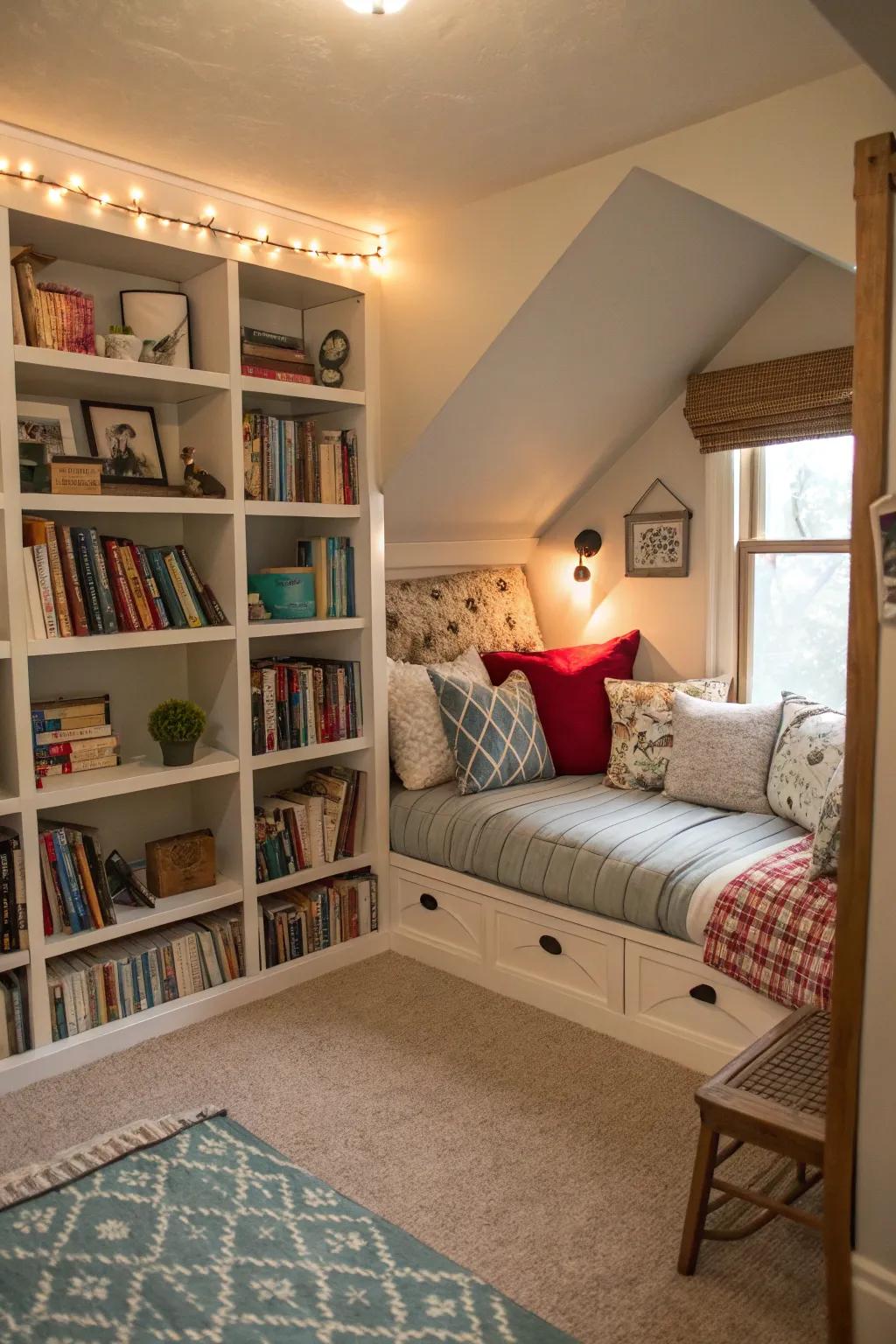
There’s a special kind of magic in carving out a little oasis just for reading—even in the busiest, most shared of bedrooms. A cozy nook becomes more than simply a place to sit; it’s a gentle invitation for imagination, reflection, and a much-needed break from the daily hustle.
I once worked with Mia and her younger sister, both passionate about books (but not always about sharing space). Their room felt tight, but by reshuffling a few items and tucking soft cushions beneath a sunny window, we created a nook that quickly became their favorite spot. Sometimes all you need is a little vision, a bit of textile layering, and a dash of creative thinking.
If you’re hoping to transform a tiny corner into a beloved reading retreat, here are a few tried-and-true steps:
- Layer plush cushions and chunky throws to invite relaxation.
- String up fairy lights overhead for a gentle, glowy ambiance.
- Place a compact bookshelf within arm’s reach to keep favorite stories close.
- Add a cozy rug underfoot for softness and warmth.
Why not ask your little ones what kind of hideaway they dream about? Their answers might surprise you—and inspire your design choices.
Create a nook that feels worlds apart, even when it’s just steps away from bunk beds and shared desks.
Maybe worth checking out:
9. Let There Be (Personal) Light!
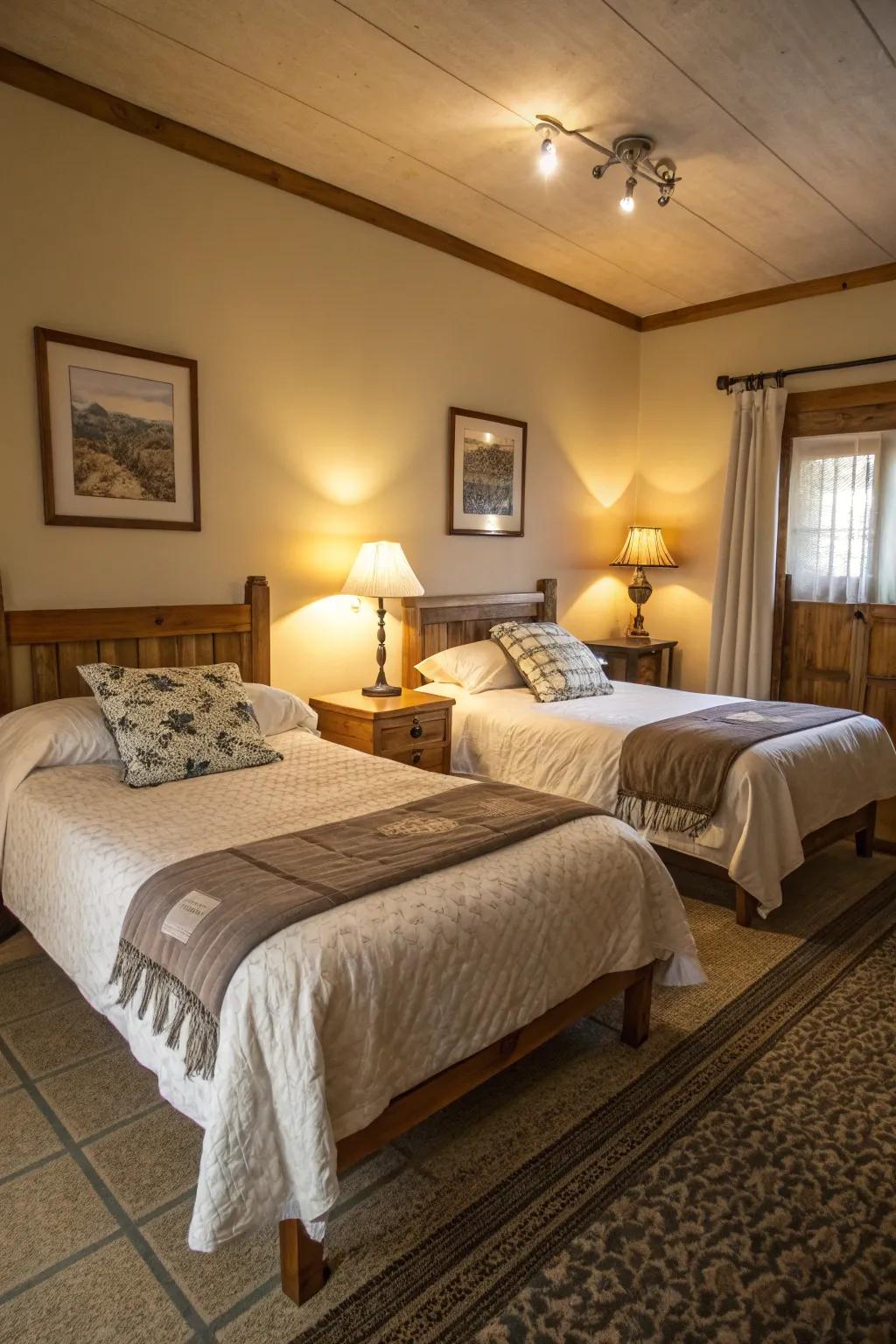
Lighting isn’t just functional—it’s the secret sauce that lets each child tailor their own bedtime ritual, homework routine, or creative downtime. Adjustable lighting over each bed is a trick I return to again and again for shared rooms, because it’s empowering and endlessly adaptable.
Isn’t it amazing how a small light can make all the difference?
When planning lighting for siblings with different habits, consider:
- Bedside wall lamps for direct, focused glow exactly where needed.
- Clip-on lights that can travel with a favorite book or sketchpad.
- LED touch night lights offering soft, reassuring comfort in the dark.
I remember working with the twins, Leo and Max, who wanted their shared room to reflect their independent spirits. Installing separate reading lights allowed Max to drift off with a story, while Leo, a budding artist, could sketch in his journal late into the evening—no arguments, just peaceful coexistence.
You might like:
10. Double-Duty Furniture: Small Spaces, Big Solutions!
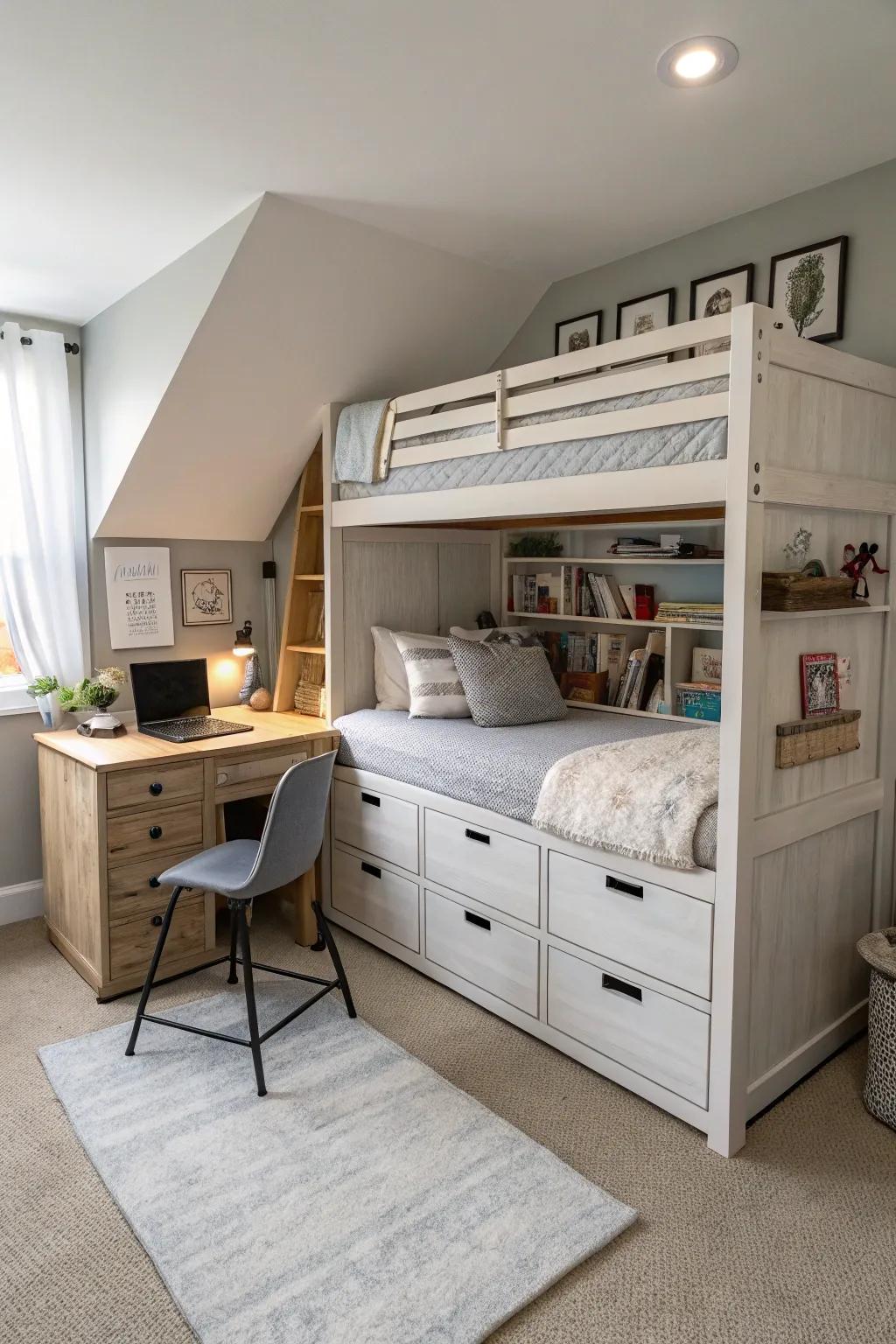
When every inch counts, I always recommend furniture that wears more than one hat. In shared bedrooms, clever pieces with hidden talents can make the difference between clutter and calm.
- Storage beds keep books, clothing, and toys tucked away neatly.
- Loft beds with desks underneath save space for both sleep and study.
- Convertible nightstands transform into study tables by day.
- Ottomans with hidden compartments corral shoes or off-season clothes.
I still remember helping Sarah, a busy mom of three, with her two oldest daughters’ room. We swapped out their single-purpose beds for a pair of loft beds, complete with drawers below and a slimline desk for each. The girls loved having their “private offices,” and Sarah finally got her wish—no more floor piles!
Think of multi-functional furniture like a secret recipe for spaciousness: you might not see everything it’s doing, but you’ll definitely appreciate the results.
Products that could assist:
11. Level Up Your Space—Multi-Level Magic!
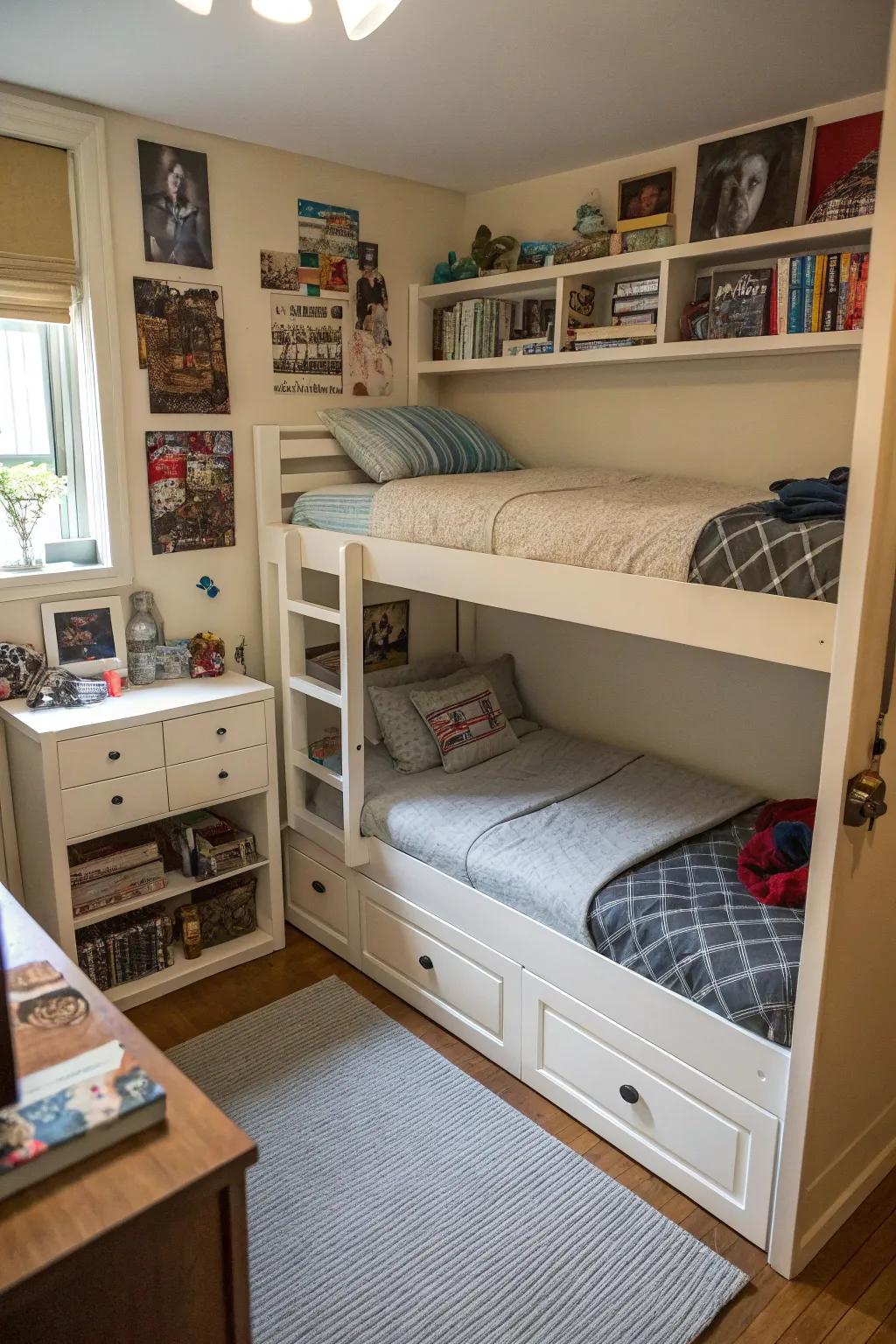
Small rooms don’t have to feel cramped or boring. Creating a multi-level layout can define zones, boost storage, and add loads of energy to a shared space. Plus, there’s just something fun about elevated beds, cozy nooks, and creative platforms—almost like your own mini-adventure park!
Multi-level designs aren’t just for big houses or fancy remodels. Here are a few approaches that work wonderfully even in the tiniest rooms:
- Bunk beds with customizable configurations – perfect for siblings with different bedtimes or study needs.
- Raised loft beds that create play or study areas underneath, maximizing precious floor space.
- Staggered twin beds with built-in steps, shelves, or cubbies to carve out individual zones.
One of my most memorable projects was helping Leo and Finn, two energetic brothers, find peace and play in a compact space. We built a staggered loft system—Leo loved his high perch for reading, while Finn used the lower bunk for building block towers. Their parents were thrilled with how tidy everything stayed thanks to storage drawers tucked around each level. Remember: multi-level layouts don’t just look fun—they’re genuinely practical. Try adding under-bed bins or a ladder shelf, and let the room grow with your children’s needs.
Designing up is often the smartest way to open up possibilities!
Some handy options:
12. Make the Most of Natural Light
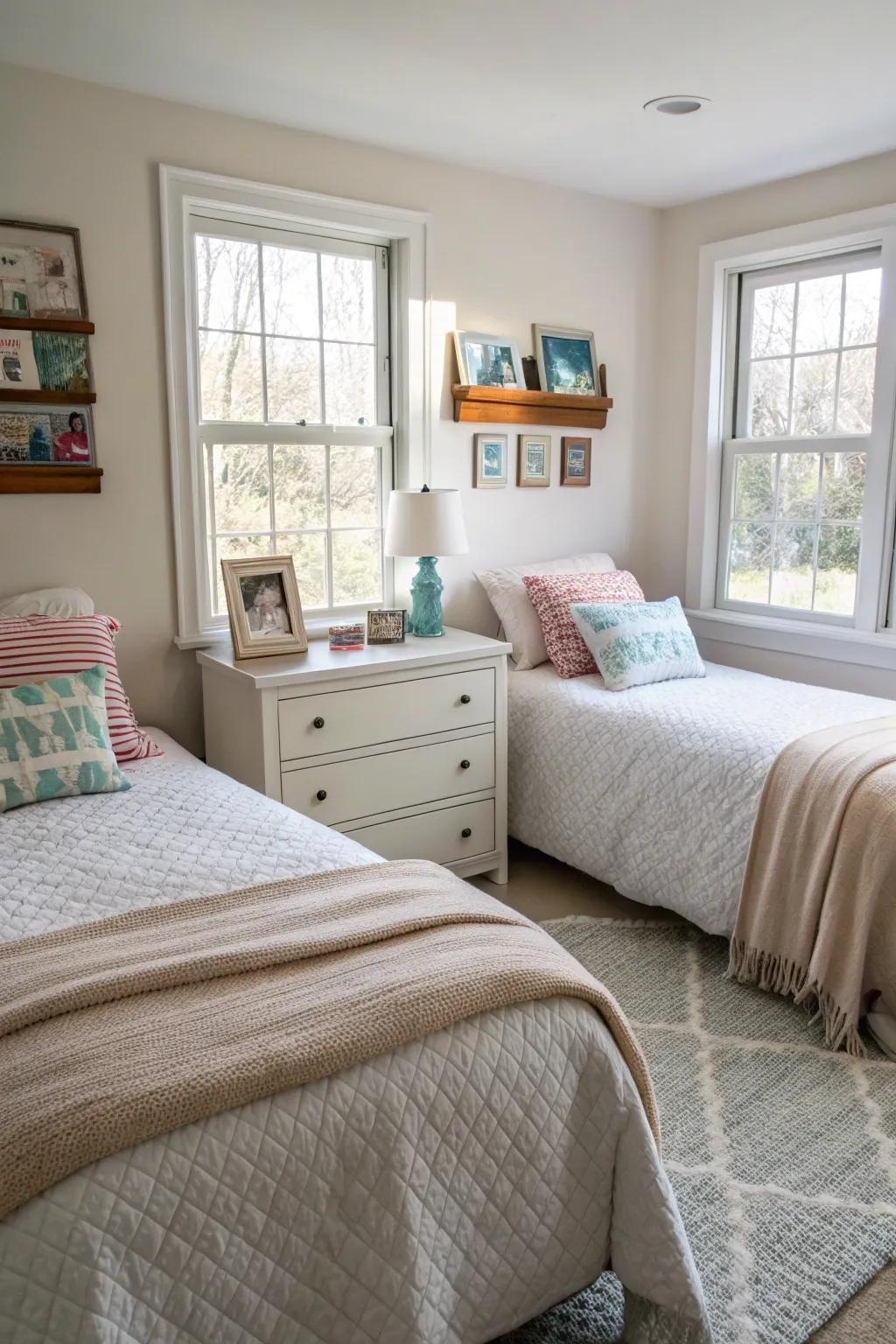
Utilizing natural light can make a small space feel bigger and more inviting. In my designs, positioning beds to enjoy sunlight enhances the warmth and brightness of the room.
Check if these fit your needs:
13. Curtain Call!

Who says you need four walls to carve out privacy? Curtains do wonders in a shared bedroom—just draw them closed at bedtime or when a little solo time is needed.
Sometimes, a simple swish is all it takes to create a world of your own.
Possibly helpful picks:
14. Why Rugs?
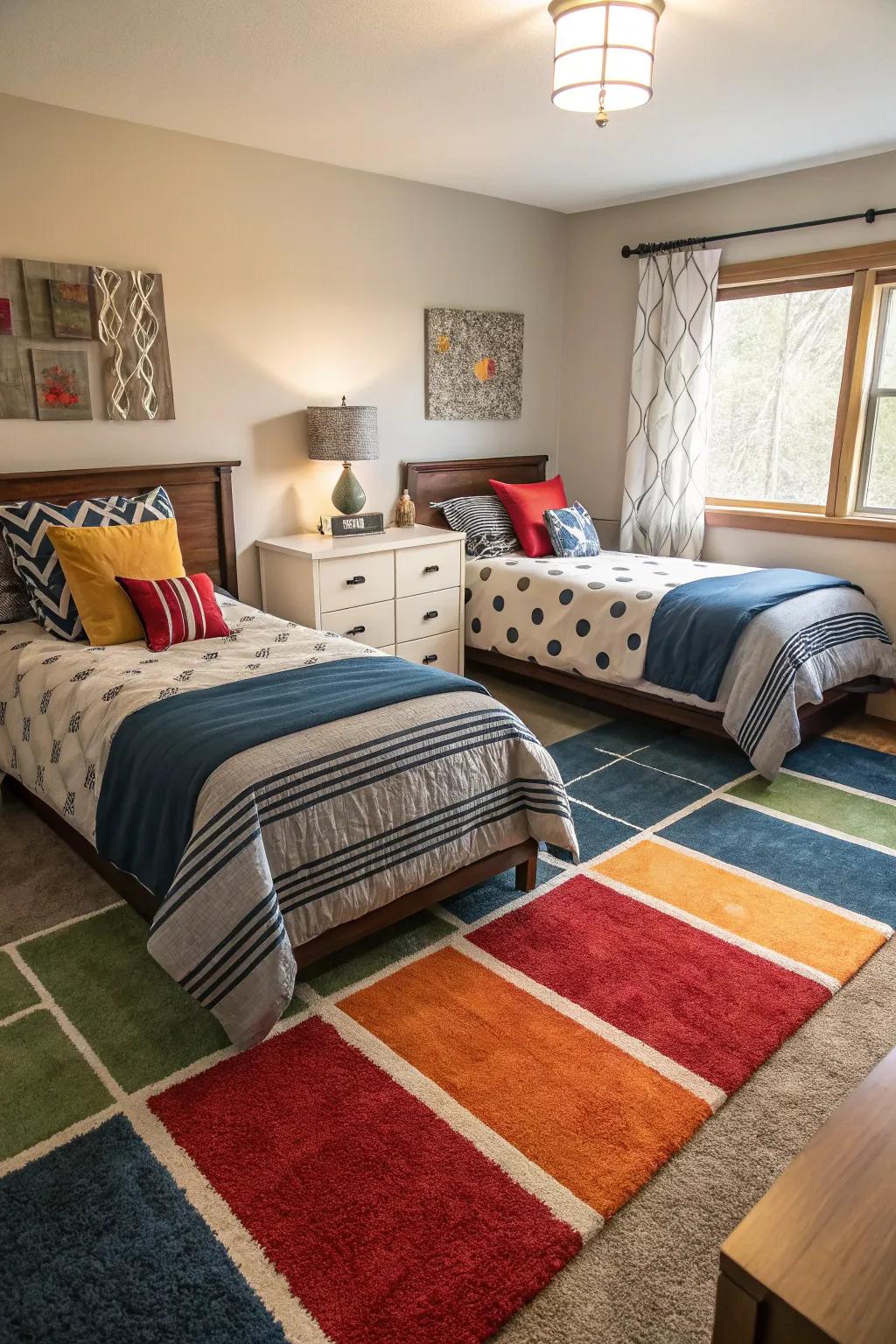
I love how a simple rug can instantly transform the feel of a room and bring a sense of order to a shared space. With one thoughtful addition, children can easily see where their special area begins and ends, making the room feel bigger and more personal at the same time.
Suddenly, a small room doesn’t feel so cramped.
Try experimenting with texture and color—sometimes, a playful pattern beneath their feet is all it takes to help each child feel at home (without building walls).
May just do the trick:
15. Could a Chalkboard Wall Spark Creativity?
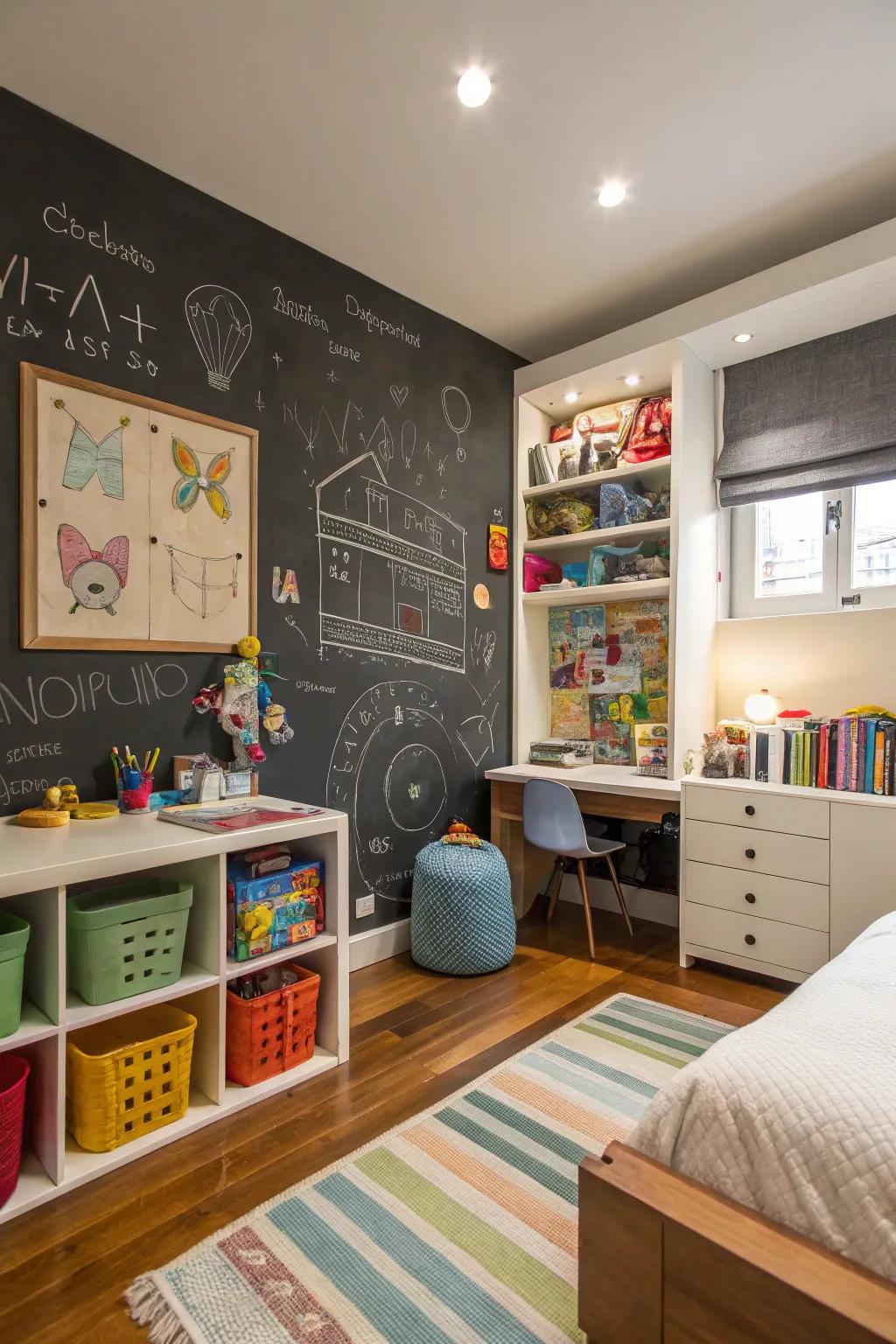
When it comes to maximizing both fun and function in a small, shared room, introducing a chalkboard wall truly changes the atmosphere. It isn’t just a backdrop – it’s an evolving canvas for doodles, reminders, and even tiny masterpieces.
I once added a chalkboard wall for a pair of artistic siblings, and it genuinely helped to define their individual spaces without dividing the room. It’s a playful, flexible solution that lets creativity bloom while keeping a sense of unity.
A few things you might like:
16. Personalize With Wall Art
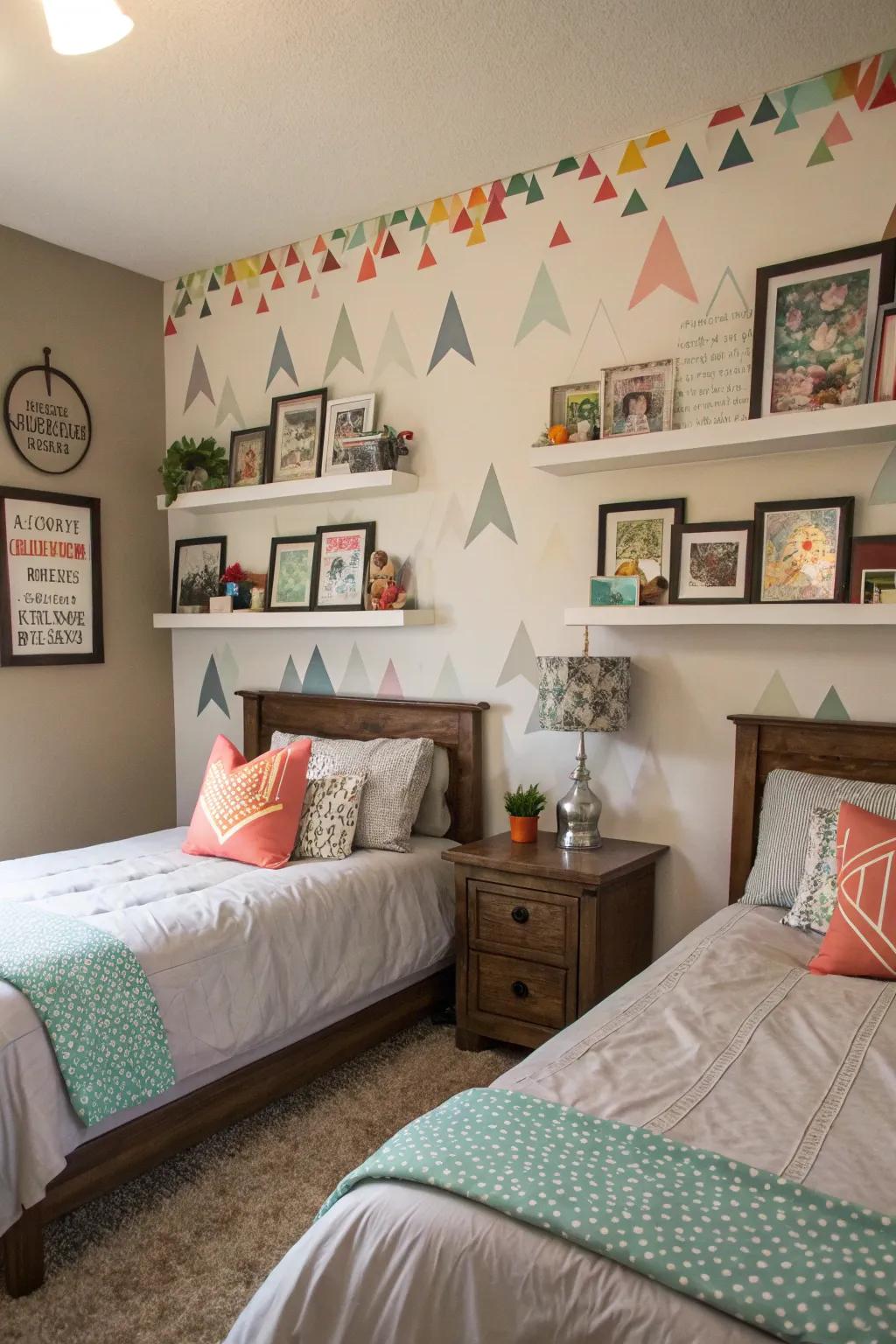
Personalized wall art works magic in any shared bedroom, instantly making the space feel special and uniquely yours. Whether it’s a stylish nameplate or a set of playful custom decals, those little touches create a sense of belonging. Isn’t it lovely when you can see your personality reflected on the walls?
That’s the power of personal detail.
These products might be useful:
17. Let Their Personality Shine!
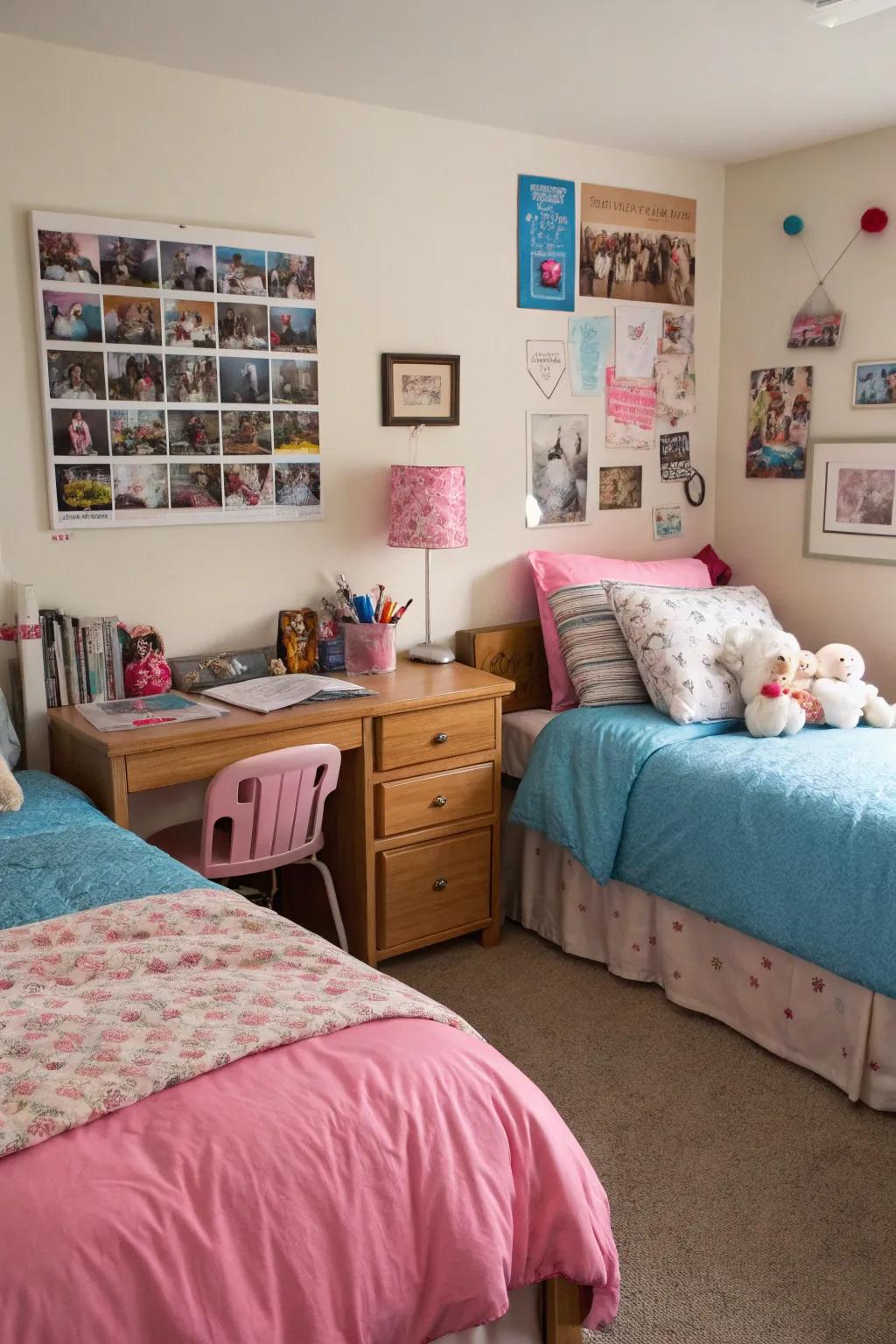
One of my favorite parts of designing a shared bedroom is seeing how each child’s style comes to life. When you invite kids to express their individuality, you create a space that truly feels like theirs.
Here are three playful ways to help each child feel at home:
- Let them pick out a bold piece of art for their side of the room.
- Mix and match patterns in bedding—let their favorite colors take center stage.
- Add personalized details, like hanging their names or beloved quotes above each bed.
“I never thought sharing a room could feel so much like my own,” one of my client’s daughters once told me, beaming as she settled into her corner full of starry wall decals and bright pillows.
Little touches of personality make every shared bedroom feel special.
Might be a good match:
18. How Much Space Can You Actually Save with a Loft Bed?
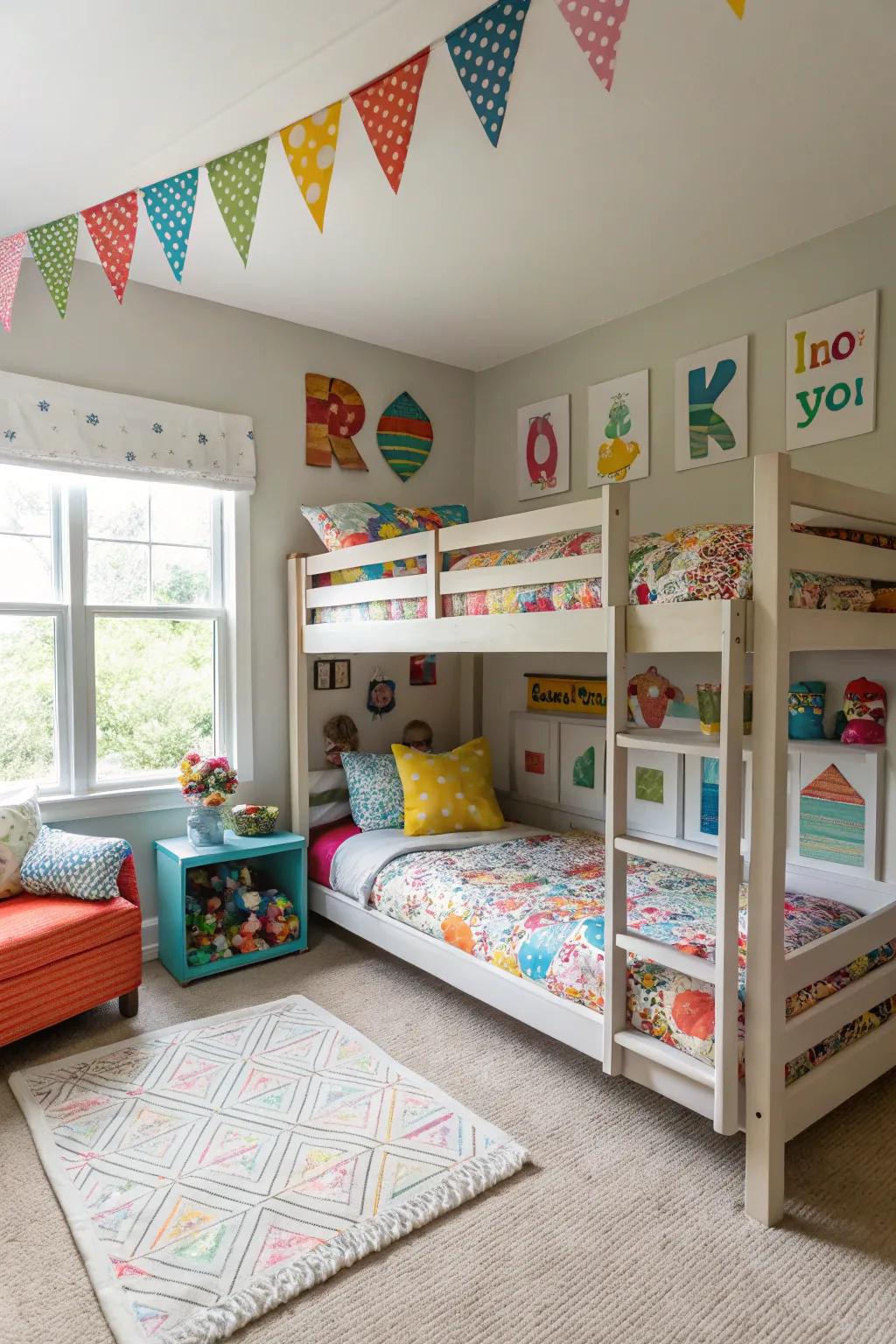
Picture this: a room where the floor is suddenly wide open and every inch feels twice as big—simply because the beds are up in the air. Loft beds are true magicians for small, shared bedrooms. By placing sleep spaces overhead, you can unlock valuable real estate for creative play zones or focused study nooks underneath. It’s a solution that’s as cozy as it is practical.
I worked with Emma and her younger brother Leo, who shared a petite bedroom with just enough space for two beds but not much else. Their parents worried about chaos, clutter, and sibling squabbles. Instead, with sturdy loft beds, we crafted a sanctuary: Emma’s side had a mini library and beanbags for reading; Leo’s nook held a colorful play tent where his imagination ran wild. Now, the room isn’t just functional—it’s the center of their happy memories together.
Every shared bedroom can blossom with the right under-bed ideas:
- Loft study zone: Add a small desk or shelving under the bed for homework and artwork.
- Hidden storage: Integrate rolling bins or drawers for toys, books, and clothes.
- Cozy retreat: Hang a curtain or play tent beneath the bed to create a comfy escape.
Loft beds aren’t just furniture—they’re invitations for creativity and independence.

